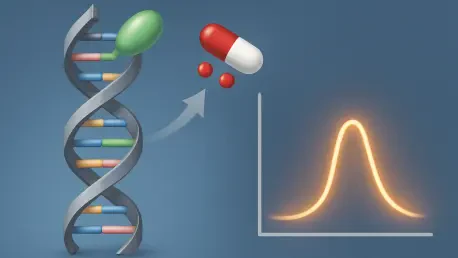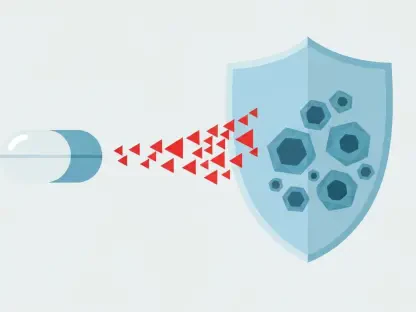In the realm of modern healthcare, ensuring the right drug dosage for each patient remains a formidable challenge, with studies revealing that up to 50% of patients on critical therapies like chemotherapy receive suboptimal doses due to individual variations in drug metabolism. This discrepancy often leads to reduced treatment efficacy or harmful side effects, underscoring a pressing need for real-time, personalized monitoring solutions. Enter a groundbreaking technology developed by researchers at Université de Montréal: a DNA-based drug sensor that promises to transform therapeutic drug monitoring by delivering rapid, affordable, and precise results directly at the point of care.
Core Features of the DNA-Based Sensor Technology
This innovative sensor leverages the unique properties of DNA molecules, specifically aptamers, to detect and quantify drug concentrations in blood with remarkable accuracy. These aptamers are engineered to bind selectively to target drug molecules, initiating a measurable response that indicates the exact level of the drug present in a patient’s system. The specificity of this binding mechanism ensures that the sensor can distinguish between similar compounds, making it a reliable tool for complex therapeutic regimens.
What sets this technology apart is its ability to produce results in just five minutes, a stark contrast to traditional testing methods that can take hours or even days. By integrating inexpensive electrochemical readers—similar to those used in home glucose meters—this system offers a user-friendly interface that requires minimal training, paving the way for widespread adoption in clinical and potentially home settings. The affordability of the hardware further enhances its accessibility, addressing a critical barrier in current diagnostic practices.
Beyond speed and cost, the sensor’s design draws inspiration from natural cellular signaling cascades, showcasing a bio-inspired approach to medical technology. This modularity allows the system to be adapted for detecting a variety of molecular targets, not just drugs, hinting at broader applications in diagnostics. Such versatility positions the technology as a platform for future innovations in healthcare monitoring.
Performance Metrics and Real-World Validation
The performance of the DNA-based sensor is notably impressive, with sensitivity levels capable of detecting drug molecules at concentrations 100,000 times lower than those typically measured by glucose meters. This high sensitivity ensures that even minute changes in drug levels can be captured, enabling precise adjustments to dosages. Such precision is crucial for treatments where maintaining a narrow therapeutic window is essential to avoid toxicity or inefficacy.
Validation experiments conducted on mice have demonstrated the sensor’s efficacy in real-time monitoring of anti-malaria drugs, providing immediate feedback that could guide clinical decisions. Unlike the gold-standard tests that often delay results, this rapid turnaround supports dynamic treatment adjustments, potentially improving patient outcomes in critical conditions. The successful application in animal models serves as a strong proof of concept for human use.
Additionally, the electrochemical signal processing at the heart of the sensor ensures consistent and reliable outputs, even in varied biological environments. The system’s ability to function with minimal calibration enhances its practicality for point-of-care settings, where time and resources are often limited. These performance characteristics underline the technology’s readiness for further clinical testing and eventual deployment.
Applications and Impact on Healthcare
One of the most promising applications of this sensor lies in therapeutic drug monitoring for life-threatening conditions such as cancer, where precise dosing can significantly affect treatment success. By enabling healthcare providers to monitor drug levels in real time, the technology facilitates tailored adjustments that optimize efficacy while minimizing adverse effects. This capability could redefine how oncologists manage chemotherapy protocols, ensuring patients receive the most effective care.
Beyond oncology, the sensor holds potential for managing infectious diseases like malaria, where drug resistance due to suboptimal dosing remains a global challenge. Its successful use in monitoring anti-malaria drugs in preclinical studies suggests a future where such tools could support rapid response in outbreak scenarios, particularly in resource-limited regions. The portability of the device further amplifies its utility in remote or underserved areas.
The broader impact on healthcare delivery could be transformative, as the technology democratizes access to advanced diagnostics. By shifting drug monitoring from specialized laboratories to doctors’ offices or even homes, it empowers patients and clinicians alike with actionable data. This shift aligns with the growing trend toward personalized medicine, where treatments are customized to individual needs rather than standardized protocols.
Challenges in Adoption and Commercialization
Despite its promise, the path to widespread adoption of the DNA-based sensor is not without obstacles, particularly in ensuring consistent accuracy across diverse patient populations. Variations in blood composition and individual pharmacokinetics could affect sensor readings, necessitating rigorous testing to validate reliability under real-world conditions. Addressing these technical hurdles remains a priority for ongoing research and development.
Regulatory approval presents another significant barrier, as the technology must meet stringent standards for clinical use. Navigating the complex landscape of medical device certification requires substantial investment and collaboration with regulatory bodies, which could delay market entry. Efforts to streamline this process are critical to bringing the sensor to those who need it most.
On the commercial front, scaling production to meet global demand poses a challenge, though progress is underway with companies like Anasens, which has licensed the patent for this technology. Market acceptance will also depend on demonstrating cost-effectiveness to healthcare systems and insurers, a task that requires strategic partnerships and robust economic data. Overcoming these hurdles will be essential to realizing the full potential of this innovation.
Future Prospects and Broader Horizons
Looking ahead, the adaptability of the DNA-based sensor suggests exciting possibilities beyond drug monitoring, such as detecting other biomarkers or even environmental molecules. Research into expanding its target range could open new diagnostic avenues, from early disease detection to monitoring pollution levels, broadening its societal impact. Such developments would require interdisciplinary collaboration to refine the technology for diverse applications.
The long-term vision for this sensor aligns with the evolution of personalized medicine, where diagnostics and treatment are seamlessly integrated at the point of care. Over the coming years, from 2025 to 2030, advancements in miniaturization and digital integration could further enhance the sensor’s capabilities, embedding it within wearable devices or telehealth platforms. This trajectory points to a future where healthcare is more proactive and data-driven.
Moreover, the democratization of such technology could reshape global health equity by making advanced diagnostics accessible in low-resource settings. Initiatives to reduce production costs and improve user-friendliness will be key to achieving this goal, potentially supported by international health organizations. The ripple effects of such accessibility could redefine patient care on a worldwide scale.
Final Reflections and Next Steps
Reflecting on the journey of the DNA-based drug sensor, its development marks a pivotal moment in the quest for precision healthcare, offering a solution that is both rapid and accessible. The technology’s ability to deliver results in minutes with high sensitivity stands as a testament to the power of bio-inspired innovation, while its validation in preclinical studies provides a solid foundation for human application. Its potential to transform therapeutic monitoring is evident, even as challenges loom on the horizon.
Moving forward, the focus shifts to actionable steps like extensive clinical trials to ensure reliability across diverse populations, alongside partnerships with regulatory bodies to expedite approval processes. Collaborations with industry stakeholders are deemed essential to scale production and integrate the sensor into existing healthcare frameworks. By addressing these priorities, the groundwork is laid for a future where real-time drug monitoring becomes a standard of care, ultimately enhancing patient outcomes across the globe.









